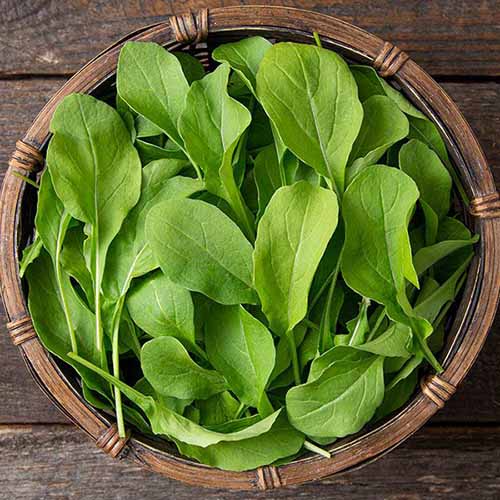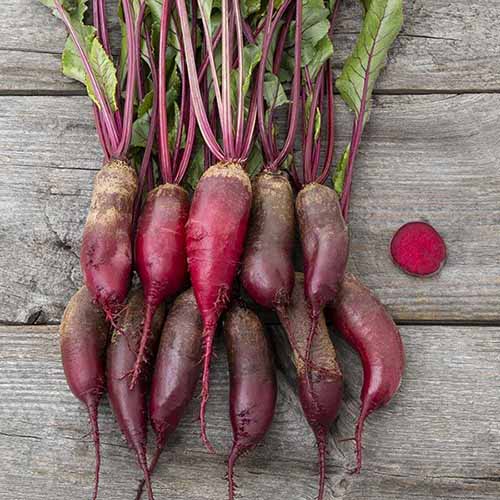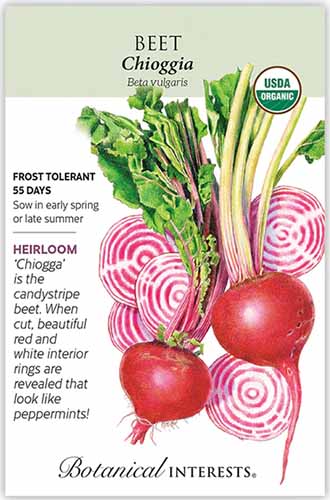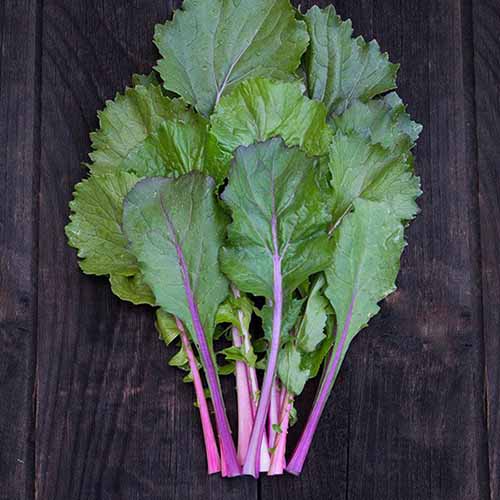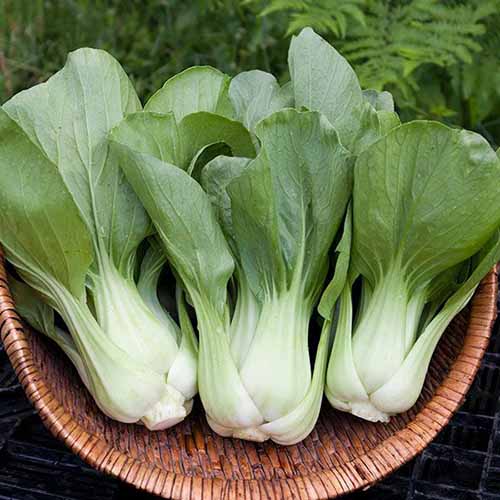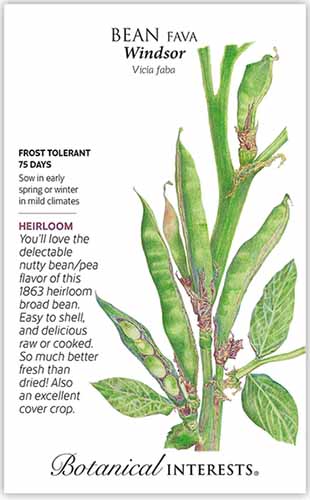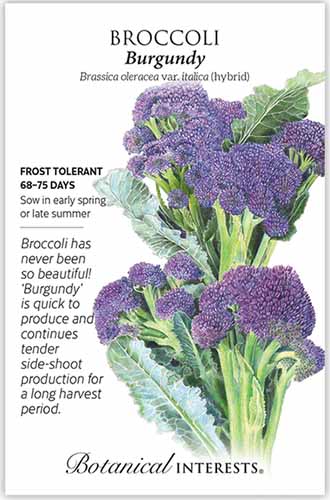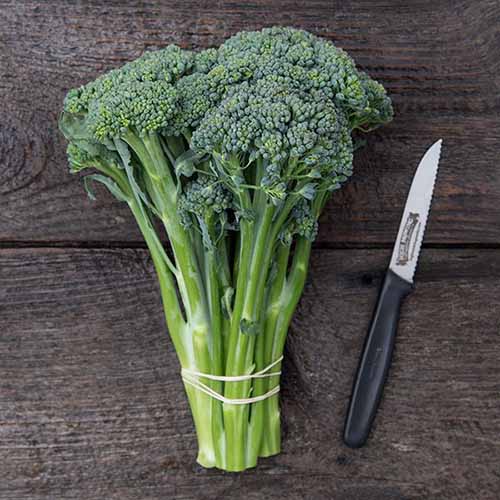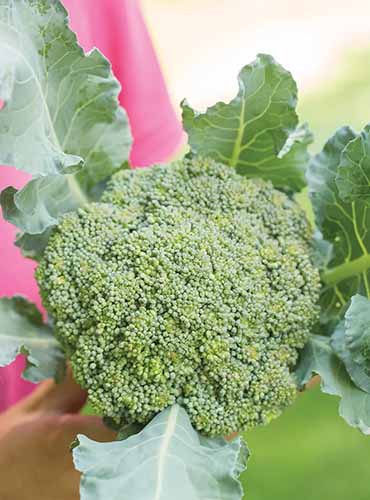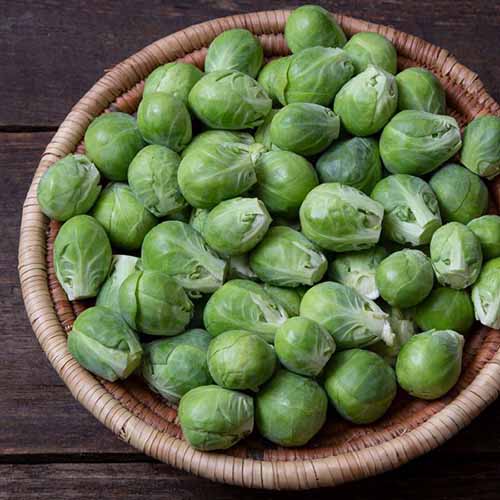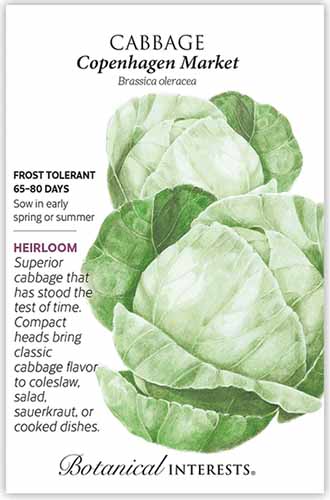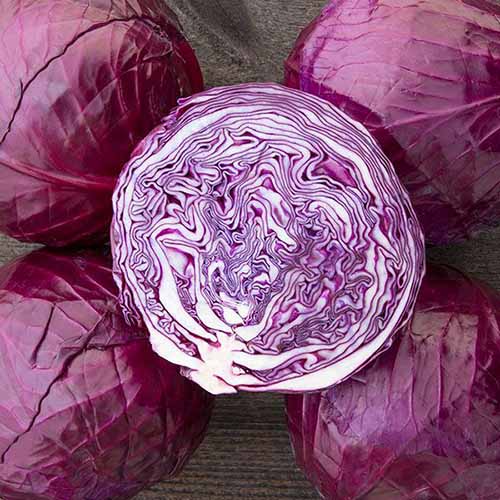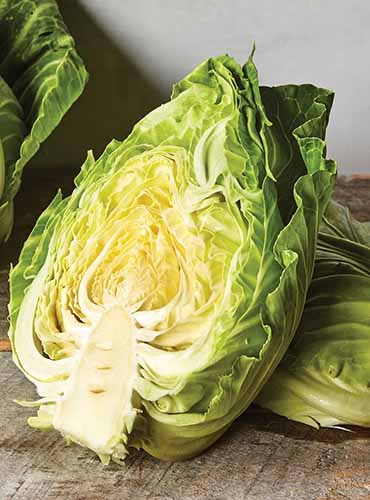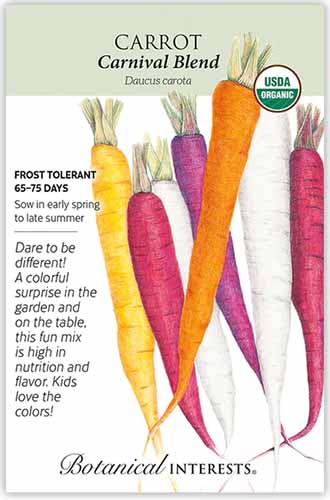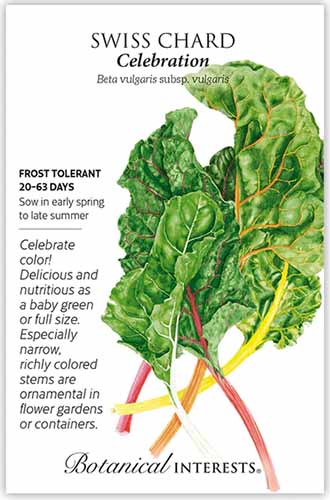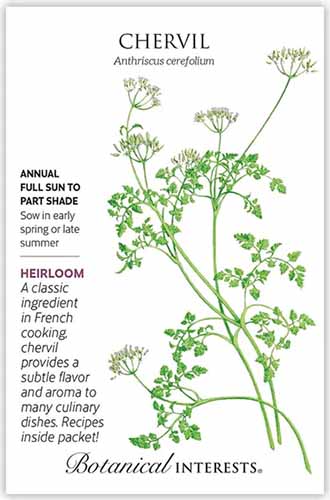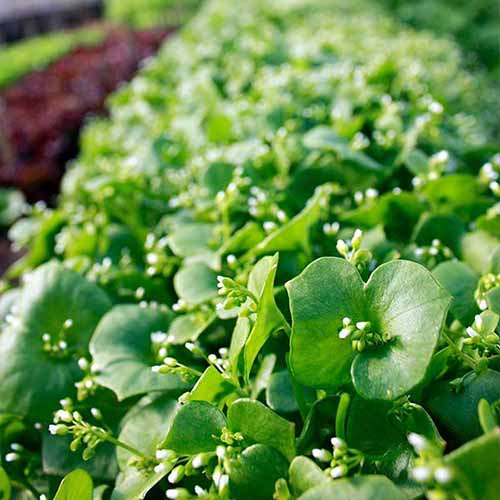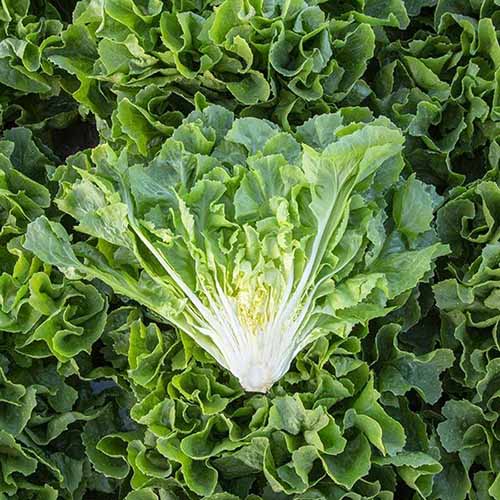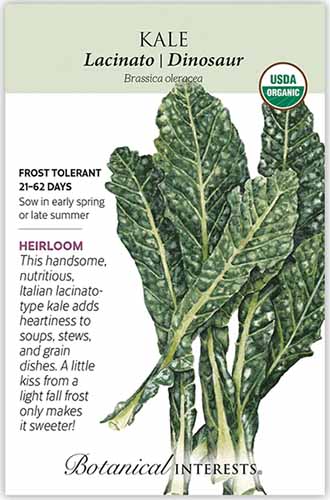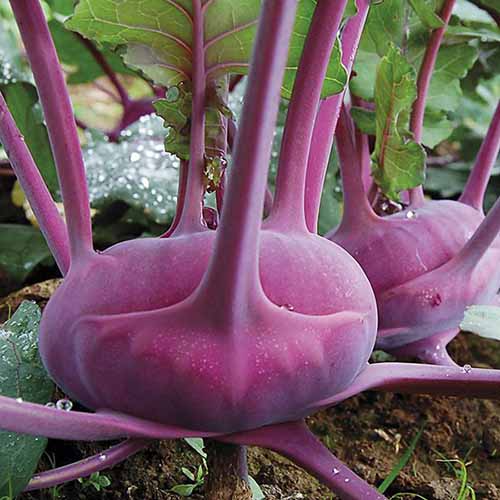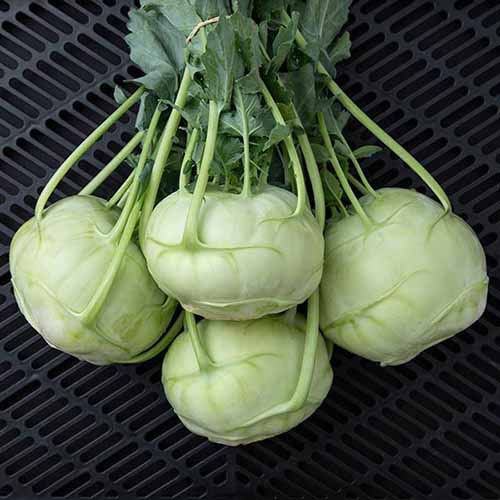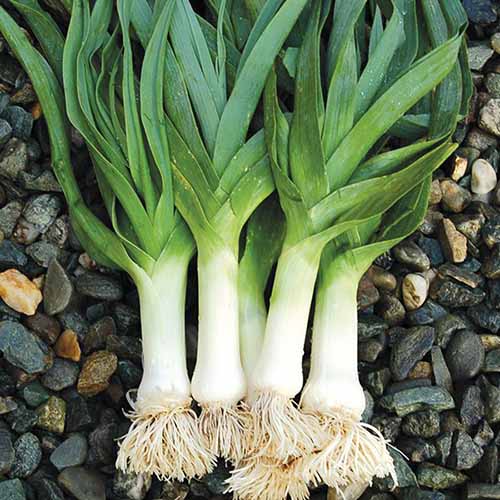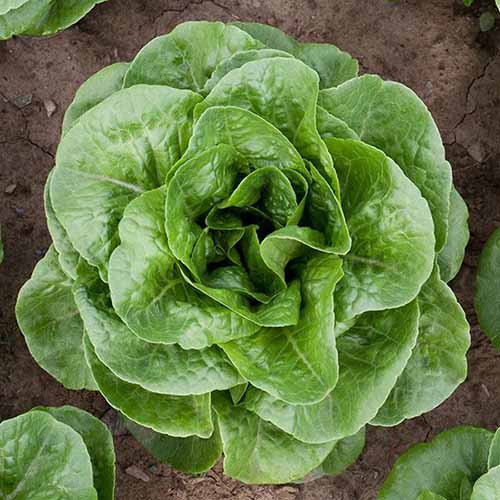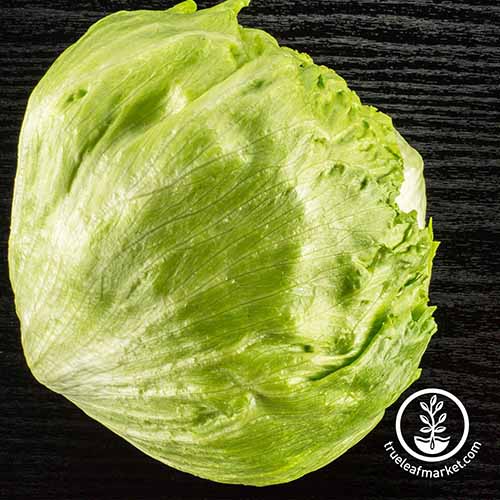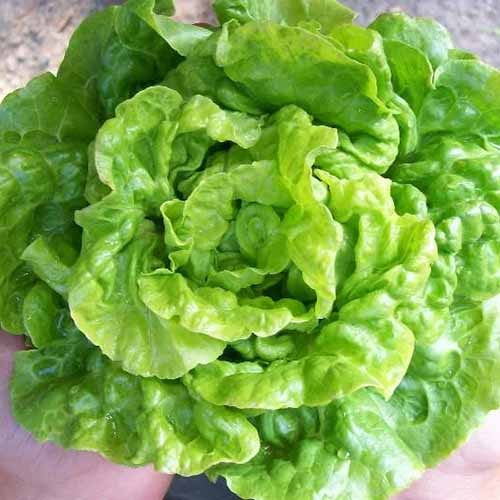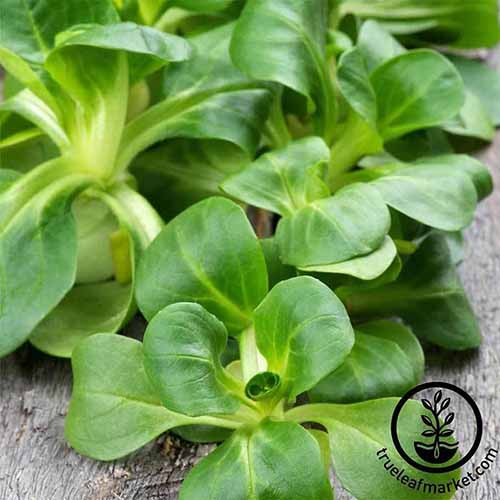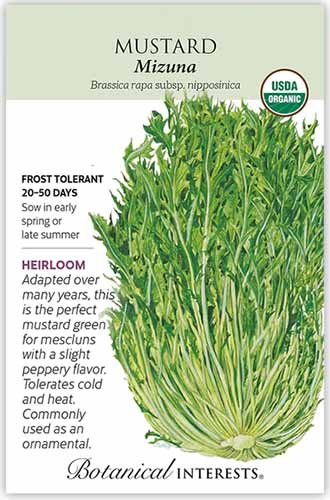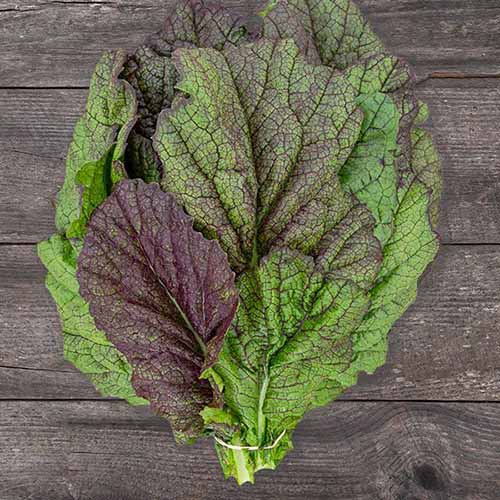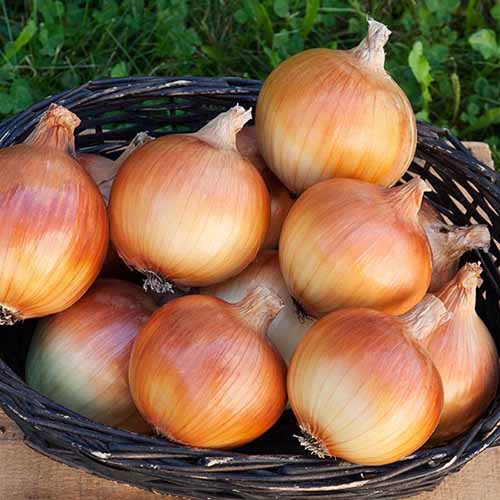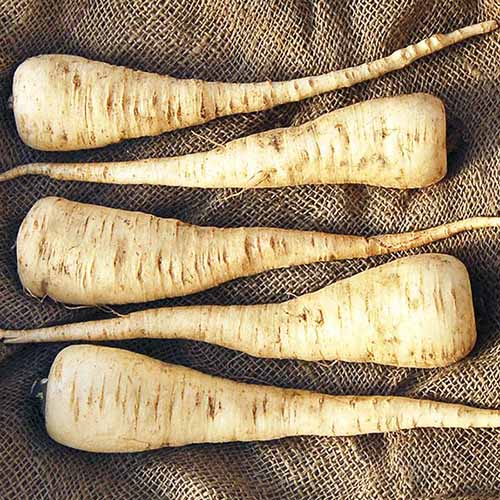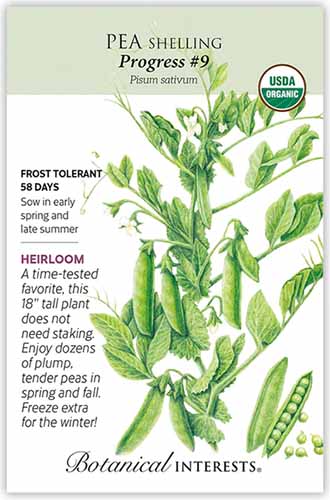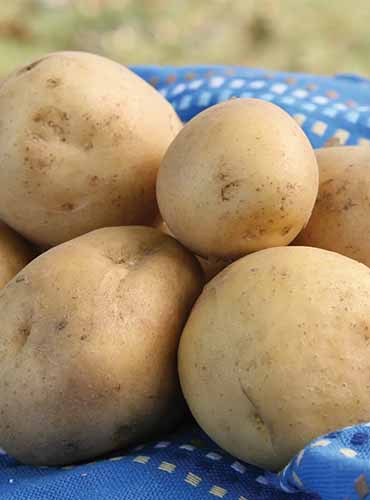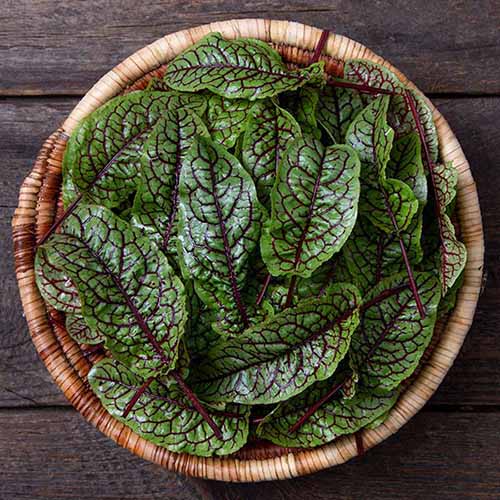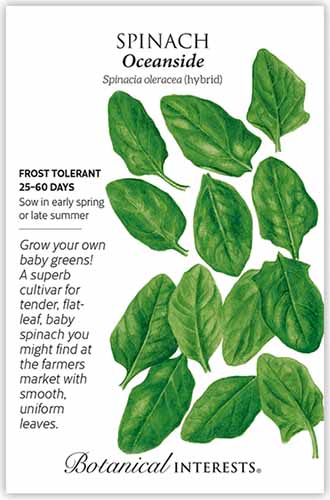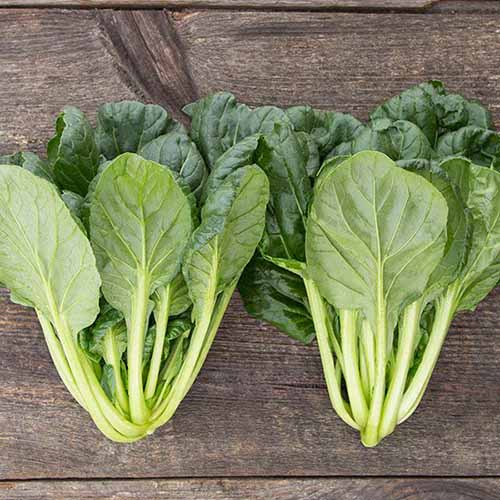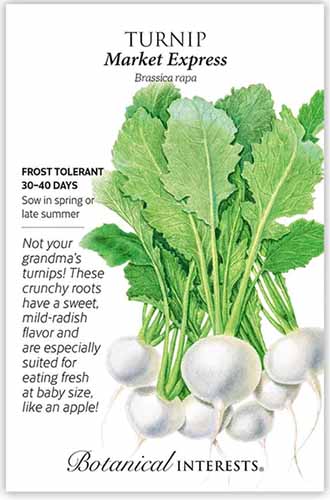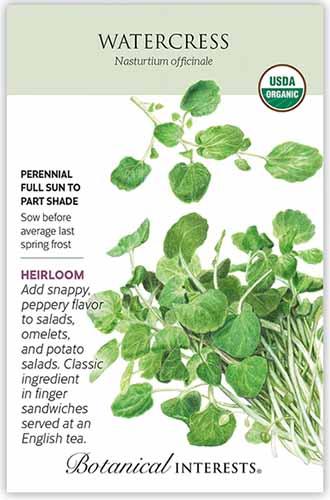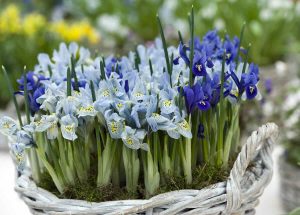
1. Arugula
Arugula (Diplotaxis spp., Eruca sativa) can handle freezing temperatures down to about 0°F, so it can easily survive in a greenhouse during the winter as far north as Zone 6. Most are ready to harvest in under two months.
My personal favorite is wasabi arugula (Diplotaxis erucoides). It has a distinct flavor note similar to the leaves of a wasabi plant (Eutrema japonicum).
It’s not for everyone, though. If you want something a bit more traditional, wild rocket (Diplotaxis tenuifolia) has a spicy flavor tempered with a bit of nuttiness.
Bring home 500 mg of seeds from Botanical Interests.
For something milder, E. sativa ‘Astro’ fits the bill. High Mowing Organic Seeds carries this commercial favorite in packets of seeds ranging from 1/32-ounce to 20 pounds.
Learn more about growing arugula in our guide.
2. Beets
Many root vegetables are perfectly happy being tucked away in the soil throughout winter, and beets (Beta vulgaris) are perhaps the happiest of all.
Make sure the container or bed is deep enough for the roots to really be able to grow as large as possible.
‘Cylindra’ offers a unique shape if you want something a little different. The roots are six inches or so long and about an inch or two wide after 60 days.
Seeds can be purchased at High Mowing Organic Seeds in packets and quarter-pound options.
Or grab some heirloom ‘Chioggia’ seeds in two-gram packets from Botanical Interests. The red and white striped roots amp up any winter dish and they’re ready in under 60 days.
Visit our guide to learn more about growing beets.
3. Belgian Endive
Belgian endive (Cichorium intybus var. foliosum) doesn’t just tolerate the winter cold, this plant requires it.
This incredible vegetable isn’t easy to grow, but we’re not afraid of a challenge, right?
Before you buy seeds, visit our growing guide so you’re familiar with the ins and outs of cultivation. Don’t worry, you’ve got this.

Belgian endive needs 120 days to mature so it’s best to start early if you can, as young plants might bolt if exposed to temperatures between 32 and 40°F – and below 32°F will kill them.
By the time it nears maturity, the plant develops a delicious flavor when exposed to temperatures below that.
By the way, if you’re unfamiliar with the process of forcing, this is a method of encouraging the plant to grow outside of its typical season.
Then, the heads are buried in straw or some other material to blanch them and make them more tender. Some plants need that process to taste good while others have more of a natural sweetness.
‘Flash’ is one of the easier cultivars to grow because it doesn’t require soil for forcing, which means you can blanch it by packing the roots together in a container and letting them grow that way. You can harvest after about 80 days.
‘Macun’ has the perfect balance of bitterness and sweet crunch. ‘Roelof’ doesn’t need soil for forcing and is pleasantly pungent.
‘Witloof’ is a perennial favorite that can be eaten without blanching after 55 days, or it can be blanched to create that classic Belgian endive flavor.
True Leaf Market sells ‘Witloof’ seeds in a variety of packet sizes and in bulk.
4. Bok Choy
Bok choy aka pak choy (Brassica rapa subsp. chinensis) is a versatile cold-weather-loving brassica that often gets overlooked in favor of more familiar crucifers. It’s worth getting to know.
Try some fun options like ‘Vivid,’ with its serrated leaves and pink to purple stems.
Packets of seeds are available at High Mowing Seeds in sizes ranging from 1/32 ounce to five pounds. It will be ready to harvest in under six weeks.
Or nab some ‘Shanghai,’ which has huge, spoon-shaped leaves perfect for stuffing.
You can find this one at High Mowing Seeds as well. Baby leaves are ready in a month and full-sized plants can be harvested in about 50 days.
Learn more about growing bok choy in our guide.
5. Broad Beans
Most beans like it hot, hot, hot. Fava, aka broad beans (Vicia faba), like it cool, cool, cool.
They’re also dual-purpose plants as you can use them as edible winter cover crops.
Just keep in mind that some cultivars need a full 220 days to mature, though others such as ‘Vroma’ are harvest-ready in just 70 days.
Unless you provide supplemental lighting in your greenhouse, it’s probably best to choose those that are ready quickly.
‘Aprovecho’ is ready for harvest right in the middle at 110 days. Heirloom ‘Windsor’ will be ready for boiling water or fresh eating like snap peas in just 75 days.
You can find ‘Windsor’ seeds in 35-gram packets available at Botanical Interests.
Check out our guide to learn more about growing fava beans.
6. Broccoli
Steam it, grill it, or eat it raw. Just don’t forget to include broccoli (Brassica oleracea var. italica) in your winter greenhouse.
Heck, you practically don’t even need the greenhouse – broccoli is very cold-tolerant and can survive down to Zone 7 without a greenhouse.
Beginners might want to try a non-heading type, also called sprouting broccoli or broccolini, because they’re a bit easier to grow.
‘Burgundy’ gives you purple to burgundy tops on a non-heading type that matures in 75 days. A packet of 10 seeds is available at Botanical Interests.
‘Waltham,’ available at High Mowing Seeds, has long stalks, which aren’t as easy to find as short-stemmed types these days.
If you enjoy eating the stems, like I do, you’ll love this one. It’s ready in just two months.
Or go traditional with ‘Eastern Magic,’ which produces large, blue-green heads in 62 days. Burpee carries both live plants and packets of 100 seeds.
Check out our guide to growing broccoli for more info.
7. Brussels Sprouts
Homegrown Brussels sprouts (Brassica oleracea var. gemmifera) are a revelation, and it’s undeniably impressive to use a stalk of them as a centerpiece for a winter party.
Maybe if our parents had served us homegrown sprouts straight off the long stalks, we might not have had several generations of sprout-haters.
There are so many fabulous options out there, you should probably check out our guide to our favorite brussels sprouts for some ideas.
Here are just a few highlights:
‘Long Island Improved’ appears on everyone’s best-of list. It’s reliable, extremely tolerant of cold, and has an excellent buttery, nutty flavor.
‘Long Island Improved’ Brussels Sprouts
Pop over to Botanical Interests to pick up a one-gram packet of seeds and you can be harvesting yours in about 100 days.
‘Nautic,’ available at High Mowing Seeds in packets of 25, 500, or in bulk, is disease resistant and vigorous. It takes a while to mature at 150 days, but it’s worth the wait.
Then there’s ‘Redarling,’ which is always the star of the dinner table with its purple-red heads. Burpee carries packets of 50 seeds or six live plant bundles. It matures in 145 days.
If this is your first go at growing brussels sprouts, be sure to check out our guide on how to make them thrive.
8. Cabbage
I used to mostly ignore cabbage (Brassica oleracea var. capitata), except in my fish tacos. That is, until I discovered grilled cabbage. Now, it’s a must-have in my garden all year long.
However you like to prepare it, cabbage is an excellent winter greenhouse vegetable. Like many of the plants on this list, it tolerates temperatures down to about 20°F.
However, seeds need warm temperatures to germinate. Either plant them in the fall when the temperature is 60°F or above during the day or start them indoors before moving them into the greenhouse.
You can’t go wrong with any of the excellent options out there, but if you’re looking for some suggestions, I’m a fan of ‘Copenhagen.’
Cultivated in Denmark in 1909, the tightly packed heads are large but still mature quickly in just 65 to 80 days.
Purchase one-and-a-half-gram seed packets at Botanical Interests.
‘Buscaro’ is an exceptional hybrid. It takes a bit longer to mature at 105 days, but the massive purple heads are worth the wait.
High Mowing Seeds carries packets of 25 or 50 seeds. The company has their seeds independently tested for black rot and black leg, which means you can rest a bit easier while growing.
If you like elongated heads, ‘Early Jersey Wakefield’ fits the bill, with super sweet, petite heads that mature in under 100 days.
Learn more about growing cabbage in our guide.
9. Carrots
Carrots hardly even flinch at the cold and frost. The tops can tolerate temperatures down to 18°F and the roots a few degrees lower.
As in the case of cabbage, carrot seeds germinate best in warmer temperatures between 55 and 65°F. They will still germinate in colder weather, but will be much slower.
It’s best to start them in the early fall or indoors on a heat mat.
I can never decide if I like orange, purple, red, white, or yellow carrots best.
You don’t have to choose with the Carnival Blend, available in 500-milligram packets at Botanical Interests.
It contains some of each color that are delicious as baby roots or you can let them grow to their full size of six to seven inches.
You can find our guide to growing carrots here.
10. Celery
Throw your celery (Apium graveolens) seeds in the ground when the soil is still at least 50°F for the best germination.
This plant needs a long time to mature, sometimes up to 200 days, depending on the variety, and it doesn’t like any heat during that time.
That’s why it’s so good as a winter greenhouse vegetable.
‘Tango’ is a popular cultivar with smooth stalks that reach up to 20 inches tall in about 90 days. Plus, if you hate pulling the strings out of your teeth, this one is nearly stringless.
High Mowing Seeds carries ‘Tango’ in packets of 100, one-, five-, or 25-million pelleted seeds.
By the way, pelleted seeds germinate better and are easier to space, so there is no need for thinning.
Celery is much easier to grow in the winter because it hates heat, but you still might want some tips on how to keep it happy. If so, check out our comprehensive growing guide.
11. Chard
Last year, I forgot about a patch of Swiss chard (Beta vulgaris subsp. vulgaris) in one of my furthermost raised beds.
After we had a rare snowstorm that dumped 18 inches in one day (we average four inches per year) and brought temperatures in the 20s for days, I figured it was destined for the compost pile.
I was wrong – it was totally fine. Translate that hardiness to the protected conditions of a greenhouse, and you know your chard is going to stick around throughout the winter.
You can harvest baby greens after about a month and mature leaves in about two months, so you can start this plant just about anytime from fall to spring.
Chard is classified in the Cicla and Flavescens cultivar groups. Celebrate the harvest with the Cicla cultivar ‘Celebration,’ a pretty rainbow type with red, magenta, orange, pink, yellow, and white stems.
This heirloom is available at Botanical Interests in one-and-a-half-gram seed packets and is ready to harvest at 55 days.
You can find more information about growing Swiss chard in our guide.
12. Chervil
A little flavor is never a bad thing, and chervil (Anthriscus cerefolium) supplies a lot in a small package.
Sometimes called French parsley, the flavor is like fennel and parsley combined. It’s an annual that will happily grow in a greenhouse through the winter down to Zone 6.
The lacy, bright green leaves lift my mood every time I walk by, and you better believe I “accidentally” on purpose brush against the plant to release its herbaceous fragrance.
The baby leaves will be ready to pluck in just 30 days and plants are fully mature in about nine weeks.
One-gram packets of seeds can be purchased at Botanical Interests.
Chervil isn’t one of the most popular plants out there, which is a shame, so if you aren’t familiar with the ins-and-outs of growing it, please visit our guide for more information.
13. Claytonia
Marvelous miner’s lettuce, also known as claytonia or spring beauty (Claytonia spp.), deserves more love.
It’s native to North America and pops up in spring with cheerful little white flowers.
You can keep it growing throughout the winter in a greenhouse for continual harvest and enjoy the sweet, crisp, juicy leaves either raw or cooked.
Enjoy the young greens after two or three weeks or the mature leaves at six weeks. High Mowing Seeds carries seeds in a variety of packet sizes.
14. Dandelion
You’ve probably pulled it out of your lawn right up until the snow buried it, so you already know how tough dandelions (Taraxacum officinale) are.
There are some fun cultivars out there. The plants probably won’t flower in the winter, but if they do, there are pink, double, or extra long petalled dandelions out there for the choosing.
But it’s not just about the flowers. The leaves are every bit as valuable as an edible green, a medicinal powerhouse, and a green mulch.
Most types are ready for the greens to be harvested in about two months.
Look for ‘Italiko Rosso’ with its bright red stems holding deep green leaves, and ‘Clio’ has uniform leaves with an upright growth habit.
Earthbeat Seeds carries packs of 100 seeds of the good old original species.
To learn more about dandelions, visit our guide.
15. Escarole
Whether you call it endive, escarole, or frisee (Chichorium endivia), this easy-to-grow green loves the cold. Plus, it’s so freakin’ good.
I love a salad, but sometimes I crave something beyond the usual lettuces and baby kale. Gimme some escarole, baby!
You can find cultivars that are ready in just six weeks or so, meaning you could probably squeeze in two crops before spring arrives.
‘Eliance’ is a smooth leaf type ready in just 35 days and provides you with flavorful heads that ramp up salads and sandwiches.
Pick up 100, 500, one million, five million, or 25 million seeds at High Mowing Seeds.
If you’re looking for tips on how to grow escarole, visit our comprehensive guide.
16. Kale
Who doesn’t adore kale (Brassica oleracea var. acephala)?
It can be so pretty that it’s practically an ornamental (and some types are actual ornamentals), and it can be eaten raw, roasted, grilled, and boiled. Each cooking method highlights a different element of the plant’s flavor.
Kids even like it, especially if you tell them they’re eating the dinosaur type. Plus, this brassica couldn’t be easier to grow – even in the winter.
Bring home kid-friendly and adult-favorite dinosaur lacinato kale seeds from Botanical Interests in one-gram packets.
You can harvest the baby leaves in about 45 days or full-sized plants in 80 days.
I always have some scarlet kale growing in my garden for the color – both as an ornamental and an edible.
Ready in 65 days, you can add some to your own greenhouse by picking up seeds in a variety of packet sizes at High Mowing Seeds.
Learn more about growing kale in our guide.
17. Kohlrabi
Kohlrabi (Brassica oleracea var. gongylodes) is so cool. It’s like a turnip and a cabbage had a baby. The crisp, sweet flesh is equally incredible raw as it is cooked.
There are both purple and green versions of this brassica. ‘Azur Star’ has reddish-purple skin that contrasts beautifully with the blue-green leaves. The flesh is exceptionally juicy.
Run over to High Mowing Seeds to bring home 25, 500, one million, five million, or ten million seeds.
If green is your thing, ‘Trero’ has thin, pale green flesh that makes it perfect for raw eating. It’s also available at High Mowing Seeds.
Kohlrabi isn’t hard to grow, but it does require some specific care. Our guide explains what you need to know.
18. Leeks
Super cold-tolerant, leeks (Allium ampeloprasum var. porrum) actually taste best when they’re exposed to some frost, though they can’t survive a hard freeze.
They give me the mellow onion flavor I crave in the winter. I toss them in soups, fry them up as garnishes, and roast them as a side dish. Chances are, leeks are on the menu at my house at least once a week from fall until spring.
‘Bandit’ is particularly happy in the cold weather. It has a thick, heavy base and deep greenish-blue leaves that are too pretty to toss out.
If you’d like to give it a try, visit High Mowing Seeds for seeds in a variety of packet sizes and you can be digging into your leeks in about 120 days.
For some tips on making the most of your leeks, visit our guide.
19. Lettuce
Lettuce is the reliable workhorse of winter greenhouse growing. You can have a continual harvest all winter long if you sow successively.
Almost any lettuce can work, but there are a few types that do especially well in the cold. Loose leaf and mesclun are generally the best for our purposes. Also, look for types that have “winter” or “hardy” in the name.
All lettuce is fine to about Zone 7, but most winter types can go down to Zone 5.
‘Winter Density’ is a romaine that germinates best in cold temperatures and has a densely packed head with an upright growth habit.
‘Winter Density’ Romaine Lettuce
High Mowing Seeds sells seeds for this this tasty lettuce in an assortment of quantities.
The baby leaves are ready in a month or you can wait two months to harvest the full-sized head.
‘Coolguard’ is an iceberg type with super crispy leaves and a mild flavor, ready to enjoy in just 70 days.
Visit True Leaf Market for a gram, quarter ounce, ounce, four ounces, or a pound of seeds.
Then there’s ‘Tom Thumb.’ Chances are, if you ask experienced gardeners for a chilly-weather lettuce option, this will be on the list.
It’s perfect if you don’t have a ton of space to spare or you don’t need a lot of lettuce all at once.
‘Tom Thumb’ Butterhead Lettuce
The small, five-inch heads of this butterhead type are ready in about 50 days, and the leaves are crisp and nutty.
Seeds are available at Eden Brothers in a variety of package sizes.
20. Mache
I first came across mache (Valerianella locusta) when I was a teenager rebelling against my family’s bland culinary traditions. Sorry, mom! We went to a restaurant that offered “unusual” foods like spinach and mache salad, and you know I ordered it. It was palate-changing!
After that, I found some seeds and grew it myself, since I couldn’t find corn salad or lamb’s lettuce, as it’s also known, in stores. That’s when I found out just how cold tolerant these plants are.
The point is that if you want something a little different from the usual lettuce that thrives in a winter greenhouse, this is it. The plants can survive down to at least 5°F and sometimes lower. That means you can enjoy it in your greenhouse down to Zone 5.
You can keep harvesting from the plant for weeks. Once the plant flowers, it’s done. You can let it self-seed or pull it and sow some more.
‘Dutch Broad,’ available in gram, ounce, four-ounce, and one-pound seed packets at True Leaf Market, is ready in 50 days and has distinctly spoon-shaped leaves.
21. Mizuna
If you like spicy greens, add mizuna (Brassica rapa var. japonica, syn. B. rapa var. nipposinica) to your greenhouse.
Some cultivars are spicy and others are mild, but they all have at least a hint of mustard pungency. All types are ready in about 40 days, so they make for a quick crop and you might be able to squeeze in more than one harvest.
This purple option, available at High Mowing Seeds in a variety of packet sizes, is mild tasting, with purple stems and heavily serrated leaves.
Or, grab the classic green mizuna in 300-milligram seed packets at Botanical Interests.
Check out our guide to growing mizuna to learn more.
22. Mustard Greens
Southern food lovers know no meal is complete without some mustard greens (Brassica juncea).
These peppery, spicy greens are magnificent raw or cooked, and they couldn’t be happier in chilly weather. While they don’t do as well in the cold as some plants, like kale and brussels sprouts, they’re fine down to around 32°F.
Mustard greens can be enjoyed as baby greens after about three weeks or at their mature size after about six weeks, depending on the cultivar.
The baby greens of ‘Red Giant’ are bright green with nearly black veins, which make a beautiful addition to salads.
High Mowing Seeds has ‘Red Giant’ seeds in 1/32, one-eighth, half-ounce, and two-ounce packets, as well as half-, one-, and five-pound packets.
‘Florida Broadleaf’ is best enjoyed as mature greens, because they are large, tender, and full of flavor. Seeds for this one can be found at Botanical Interests in two-gram packets.
Learn more about growing mustard greens in our guide.
23. Onions
Many gardeners prefer to grow their onions during the winter because it gives a long time for the plants to mature without the heat that causes them to bolt.
Growing Allium cepa in a greenhouse allows you to cultivate nearly any type of onion, not just the varieties described as “winter types.”
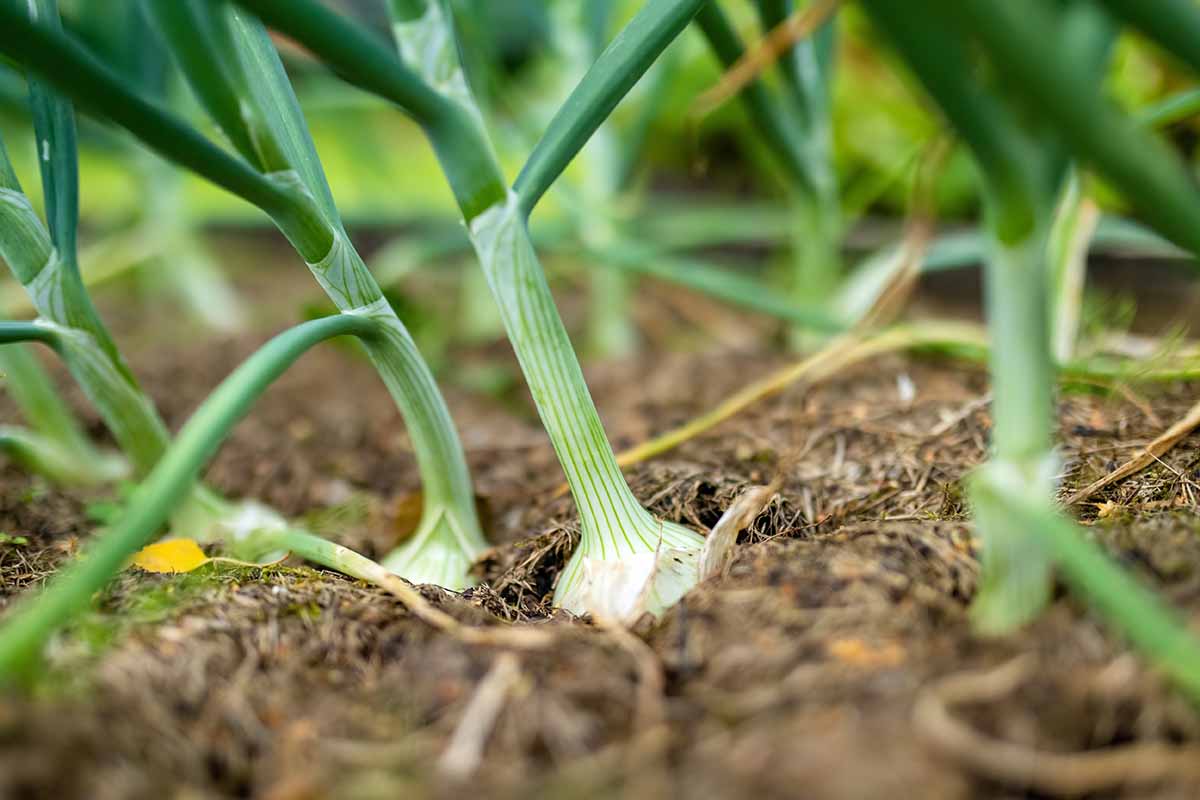
Of course, you can grow both, if you choose. As long as your greenhouse stays above 15°F or so, you can plant onions.
There are a lot of options out there, so if you don’t know where to start, look for something like ‘Dakota Tears.’
This cultivar was bred by Dave Podoll over 20 years to produce large, one-pound onions that are ready in 112 days. It is notoriously tough, resisting most diseases that plague other onions.
You can purchase ‘Dakota Tears’ seeds at High Mowing Seeds in a variety of package sizes.
Learn more about growing onions in our comprehensive guide.
24. Pansies
There’s no better antidote for the winter blahs than a crisp salad topped with fresh edible flowers like pansies (Viola spp.).
In fact, you don’t even need the greenhouse if you live in Zones 7 and up, but those in Zones 4 to 6 can find pansies that will thrive in a greenhouse environment. Winter pansies (V. hiemalis) are particularly cold hardy.
‘Plentifall Frost’ has a trailing growth habit making it ideal for hanging baskets or to spread along the edge of a large bed or container.
You could even combine it with some kale or chard in the center of a container for an ornamental look made out of edible delights.
Pick up some of these white and lavender flowers at Burpee. They carry bundles of four live plants.
Learn more about how to grow pansies in our guide.
25. Parsnips
Parsnips (Pastinaca sativa) don’t just tolerate the cold, they need it.
When their roots experience a freeze, they just get sweeter and sweeter. They grow in Zones 2 to 9, so almost anyone in the continental US can grow them in a greenhouse.
If your unheated greenhouse drops to freezing now and then, add parsnips to the mix. Even if it doesn’t drop below freezing, you can still enjoy them, but they won’t be as sweet.
‘Lancer’ has a long, uniform root and is resistant to common problems like canker.
The foot-long roots need a deep bed, so keep that in mind, and they take 120 days to mature so plan ahead. High Mowing Seeds has seeds in 1/32-, one-eighth-, and two-ounce quantities.
You can find more information about parsnips and how to grow them in our guide.
26. Parsley
Whether you prefer curled parsley or the flat leaf type, both are cold weather tolerant and won’t bat an eye at the winter chill.
And since Petroselinum crispum is packed with Vitamin C (as well as A and B), you can stave off winter scurvy with your herb patch. Or, if you aren’t a sailor on a ship in the 17th century, just keep bland winter food at bay.
I keep both types in my garden. Why choose?
Grab a gram of ‘Moss Curled’ parsley seeds at Botanical Interests, and add a gram and a half pack of flat leaf parsley seeds to your Botanical Interests cart while you’re at it.
Both are ready to eat if you harvest judiciously in about two months, but plants will reach maturity in about 100 days. Then, you can harvest to your heart’s content.
To learn all about growing parsley, please check out our guide.
27. Peas
Unflinching down to 20°F, peas (Lathyrus oleraceus syn. Pisum sativum) are perfect for your winter greenhouse.
Look for cultivars that don’t grow too tall or you might find the vines outgrowing your space.
‘Oregon Sugar Pod II’ are exceptional snow peas and they only grow about 28 inches tall. They’re full of flavor and the plants are disease resistant.
You can find a 15-gram packet of seeds at Botanical Interests and then visit our guide to growing ‘Oregon Sugar Pod II.’
Start them in the fall and be dining on your pea harvest in just two months.
Or, if you’re more of a shelling-pea fan, ‘Progress #9’ is a prolific producer that is wilt resistant.
Nab 15 grams of seeds for your greenhouse at Botanical Interests. They’re ready in about 65 days.
Learn more about how to grow peas here.
28. Potatoes
Most potatoes (Solanum tuberosum) aren’t frost hardy, or they can tolerate only a light frost, so you shouldn’t grow them in a region where temperatures drop any lower than about 25°F.
That means they’re only good to about Zone 7b in a greenhouse. But I can tell you from experience that they’re tougher than they seem.
This last winter, we had a cold snap that dropped the temperature down to 11°F and my potatoes, which weren’t protected by anything, survived just fine.
A cultivar like ‘Kennebec’ only needs about 80 days to reach maturity, and they’re extremely versatile in the kitchen.
Burpee carries packages of 10 tubers if this option sounds right for you.
Keep in mind that in some areas in more northern latitudes, you might need to provide additional light. Potatoes really need about eight hours per day, otherwise growth slows or even halts temporarily until the days get longer.
Learn more about growing potatoes in our guide.
29. Radicchio
Since radicchio (Cichorium intybus var. foliosum) tolerates frost, you know it’ll be fine in your greenhouse.
It’s good to go anywhere that stays 20°F and above, so even if your greenhouse gets that cold, it will be fine.
I tried a new-to-me cultivar last year called ‘Rosa Scarlatta’ that looks so pretty it might as well be ornamental. It has raspberry, rose, and white speckled leaves.
The six-inch heads are ready to pull after just two months. Squeeze in a crop or two during the winter!
Visit High Mowing Organic Seeds to nab yourself some seeds.
Check out our guide to learn more about radicchio.
30. Radishes
Radishes (Raphanus sativus) rock for winter growth, not only because they can handle temperatures down to 20°F (so it could be 10°F outside), but they grow so quickly that you can squeeze in several rounds with succession planting.
I keep a kind called ‘De 18 Jours’ in my garden year round – “18 jours” is French for 18 days and that’s how fast they’re ready for harvest. Others can take a month or so.
It’s one of those plants that I have growing all year long, so it’s a good thing I love them! Whether you opt for super spicy types or something a bit more mellow, they’re reliable roots that will add flavor and nutrients to your winter meals.
The Easter Egg Blend, available in four-gram packets at Botanical Interests, provides lots of color on inch-sized, round roots.
Learn how to grow radishes in our guide.
31. Sorrel
Sorrel (Rumex acetosa, R. sanguineus, R. scutatus) is super duper cold tolerant. Not even 0°F scares it. It’s also tolerant of lower light, which makes it a fabulous winter option.
The leaves of red-veined sorrel (R. sanguineus) are deep green with maroon veins. Super pretty.
Baby greens are ready in 45 days and mature plants are ready in 55 days at which point you can dig into the tangy, crisp leaves.
You can find seeds in all kinds of packet sizes, from 1/32-ounce to five pounds, at High Mowing Seeds.
Learn more about growing sorrel here.
32. Spinach
Spinach (Spinacia oleracea) is a cool-season veggie that does best when the weather is chilly. Anything down to 20°F is fine as far as spinach is concerned.
The versatile leaves are marvelous to have around as the winter drags on.
I don’t know what I’d do without them on my sandwiches and in my stir-fries during the chilly months. I’m making these spinach ricotta calzones from our sister site, Foodal with my next harvest.
While any type of spinach will work in a winter greenhouse, ‘Oceanside’ is ready in just 25 days with plants maturing at 60 days in the winter.
Pick up a two-gram packet of seeds at Botanical Interests.
Check out our guide to learn more about growing spinach.
33. Tatsoi
Do you have that friend who never seems to feel the cold?
You’re out there wrapped up in 17 layers of clothing and they’re bopping around in a t-shirt and jeans? That’s tatsoi (Brassica rapa subsp. narinosa), a particularly cold-tolerant close relative of bok choy that’s sometimes called tat choy.
Hardy to -20°F, when the weather is freezing, tatsoi is out there saying “what’s the big deal?” That means even folks in Zone 4 can enjoy it in their winter greenhouse.
If you’ve never had tatsoi before, it’s a type of mustard green and it tastes fantastic. Baby greens are ready in three weeks and the full heads are mature in 45 days.
You can buy seeds at High Mowing Seeds in quantities from 1/32 ounce to five pounds.
34. Turnips
Turnips (Brassica rapa subsp. rapa) grow well in temperatures down to 25°F and they hate hot weather, so winter is when they shine.
I know these root veggies are sometimes held up as the poster child for boring fare, but I heartily disagree.
At the very least, try making them into spicy chips. Something tells me the turnip haters in your life will be changing their tune. You can nab the recipe from our sister site, Foodal.
‘Market Express’ has pure white, two-inch roots that are ready in just 40 days or, if you’re in a rush, they can be harvested as baby roots in just 30 days.
Bring home some seeds from Botanical Interests in 400-milligram packets.
Our guide to growing turnips has more information.
35. Watercress
This green is at one with the cold. Hardy down to 5°F – Zone 6 in a greenhouse – watercress (Nasturtium officinale) is a moisture-loving brassica that provides flavorful greens all winter long.
They mature quickly, with some types ready to harvest after just three weeks.
You can often find watercress as live plants at grocery stores, but it’s so much cheaper to grow your own from seed and you can cut and come again for weeks and weeks.
Buy 200 milligrams of seeds at Botanical Interests.
Winter Doesn’t Mean the End of Good Eating
We talk about the fall harvest as a time of abundance, but that doesn’t mean it has to end when autumn gives way to winter.
Modern conveniences like greenhouses let us cheat Old Man Winter out of his plans to put a stop to the growing season. There are far more plants that can grow in cold weather than many people realize.
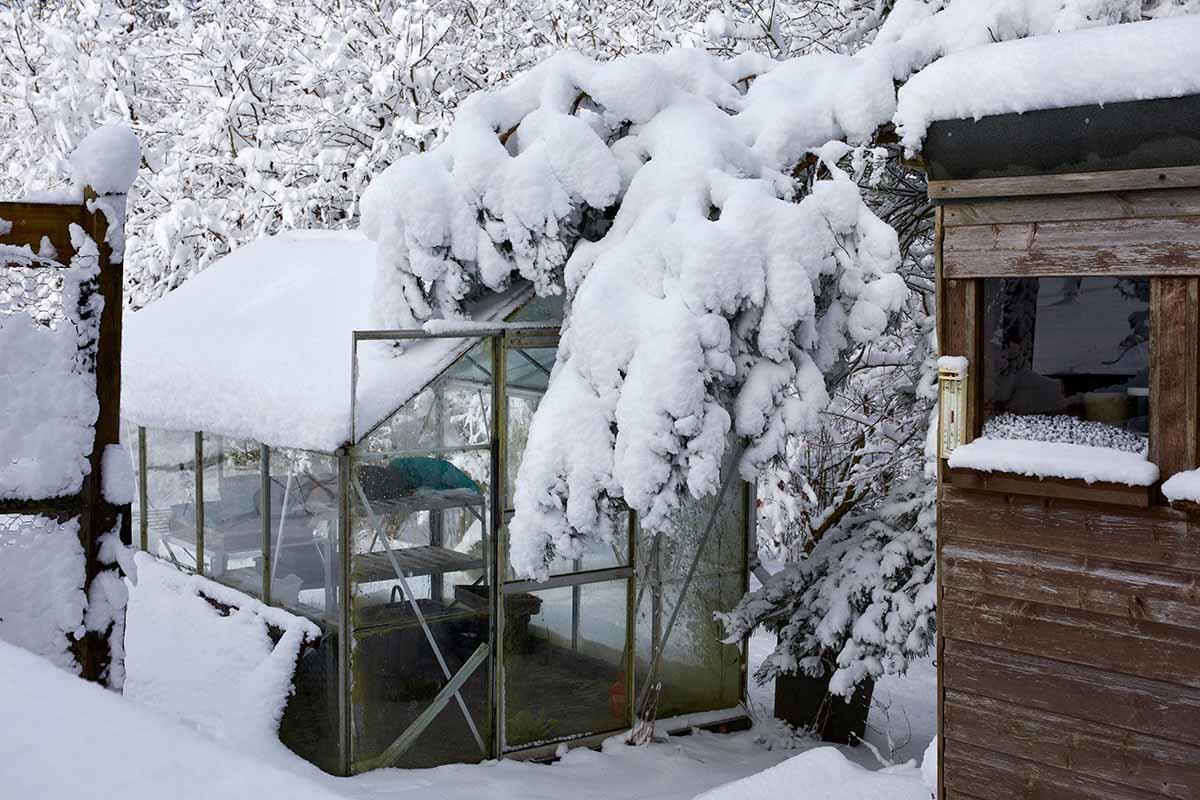
Which species are you going to grow in your greenhouse? Let us know how you plan to use them in the comments section below!
If you’re looking for some additional ways to make use of your greenhouse, we have a few guides that might be helpful. Check these out next:
